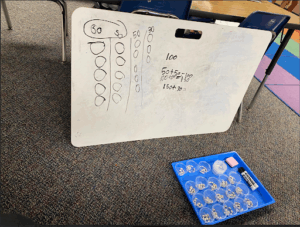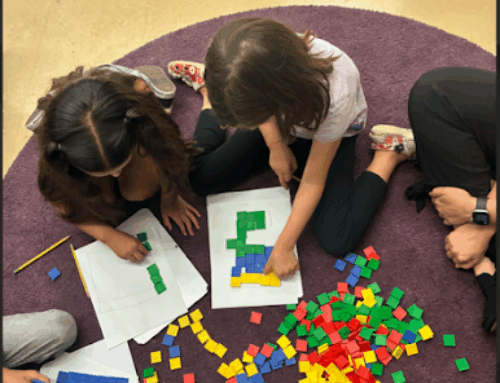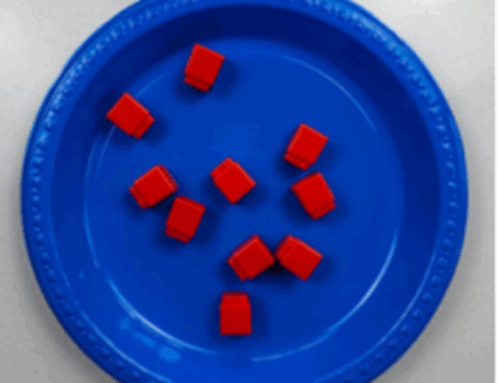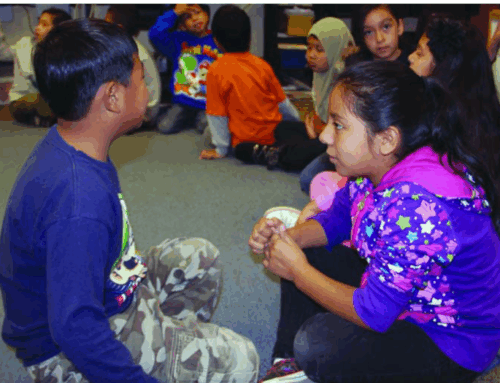Counting Collections in the Primary Grades

Rusty Bresser
 What are Counting Collections?
What are Counting Collections?
When I first heard of Counting Collections, my first thought was, “What’s the big deal?” But as I learned more, I soon realized that this deceivingly simple activity is in fact a rich math experience that has the potential of engaging children in deep learning about number and computation. Here are the features of Counting Collections:
- Children count a collection of objects that are stored in a zip-lock baggie.
- Children choose how to organize, count, and record the total, and whether to use tools such as ten-frames or containers to help them.
- While children count, the teacher circulates the classroom, observing and asking questions to support students’ counting.
- The teacher summarizes the activity by having students share their strategies and helping them reflect on what they learned while counting.
Counting is Important
In their book Choral Counting & Counting Collections (Stenhouse Publishers, 2024), Franke, Kazemi and Turrou note that,
“Counting is fundamental to learning mathematics in elementary school. It supports the development of a deep understanding of number, providing the core foundation for understanding place value, how numbers are composed and decomposed, and how they are related. This deep understanding allows students to operate on them in powerful ways.”
Counting Collections in kindergarten can support children’s development of counting concepts such as one-to-one correspondence, cardinality, number sequence, number names, and how to write numbers. In first and second grade, children can get further practice with these important concepts and skills while also gaining understanding of grouping and base ten concepts as well as experience with combining quantities.
In the Classroom with Second Graders
Math Transformations consultant Susan Scharton recently spent a day with the second-grade teachers at an elementary school in Vista, California planning, teaching, and reflecting on Counting Collections. Susan was so excited about how the day went that she called to tell me what had transpired, and we both agreed it would be worthwhile to share with others in a post. So here goes!
Getting Ready
Before trying out the activity, Susan met with three second grade teachers with the goal of planning and co-teaching the lesson in several different classrooms. After each lesson, the teachers would gather, reflect on how it went, discuss what they learned, adjust the lesson if needed, and then teach it again.
Susan brought in bags of objects (snap cubes, dice, pinto beans, centimeter cubes, macaroni, buttons, etc.) enough for one bag for every two students, with quantities of objects ranging from 70ish to about 600. She also brought white copier paper for children to record their counts, as well as some supporting tools such as ten-frames and portion cups if needed.
Because Susan wanted the teachers to take ownership of the lesson, she had them brainstorm a list of questions to consider while planning:
- Should students work in partners or by themselves (they decided on partners to increase communication)?
- Are students familiar with using manipulatives?
- Have students done collaborative work? If not, what supports might they need?
- Should they have access to counting aides (ten-frames, hundred charts, portion cups)?
- Should we model ways to count and how to record or, leave that up to the students?
- What questions should we ask while monitoring students’ counting? How much support should we provide?
Teachers were interested in two questions:
How does offering choice in what to count/how to record affect the level of engagement?
When we let students choose how to count/record, what are they likely to do?
Launching the Lesson
“Today we’re going to work on counting,” Susan began. “Why is counting important?”
“To know how many you have,” they responded (succinctly!).
Then Susan asked the class to share different ways to count. They knew about counting by 1’s, 2’s, 5’s, 10’s, 20’s, 50’s, 100’s, and for each suggested way to count, Susan led the class in skip-counting.
Next, Susan showed the class the Counting Collections baggies and shared a sentence frame they could use to record their count: I counted by _____ and got ____.
Finally, students paired up, grabbed a baggie, a tray to “contain” their collection, recording materials, and went to their respective places in the room to get started. It was their choice whether they wanted any supporting tools/organizers such as ten-frames, 1-100 charts, or portion cups.
Exploring
Susan was astounded by the high level of engagement. Students were on task throughout the 30 minutes they were given to count and record their collections.
This pair of students (see below) organized their cubes in trains of 10, then recorded the count totaling 220. Notice how they struggled a bit with recording past 100 but then got back on track.

Teachers were struck by how many ways students chose to organize and record their counts (see example below).

Counting Collections provided these second graders with opportunities to practice combining groups. Notice how this pair (see below) grouped their beans by 20’s (not all the cups are shown) and then added 20 five times to get to 100 and then repeated that strategy until they reached a total of 611.
The Common Core Standards expect second graders to add and subtract numbers to 1000 using concrete materials. Counting Collections provides an interesting context to address this standard.

This pair of students (see below) found a shortcut way to show how they organized their count in groups of ten, then used addition to find the total

Questions to Ask
As teachers circulated, they asked questions that served to further students’ math thinking and strengthen their social skills. Following are some examples.
- How will you count this collection?
- How did you decide together what to count by?
- Does your picture match what your count looks like?
- Are you sure that is how many there are? How do you know?
- Is there a tool that could help you to know what the next number is?
- What does that number look like when you write it?
- Is there a way we could keep track to be sure to count each one?
- So how many are there (this checks for cardinality– the last number stated represents the total amount)?
Surprises!
 As teachers circulated and observed children count and record, they noticed strengths in their students’ abilities. Their second graders were able to make good decisions about how to organize their objects, choose which tools would help them, and use addition in efficient ways to find their final counts.
As teachers circulated and observed children count and record, they noticed strengths in their students’ abilities. Their second graders were able to make good decisions about how to organize their objects, choose which tools would help them, and use addition in efficient ways to find their final counts.
There were also surprises about students’ gaps in knowledge. For example, when Susan visited this student (see below), she asked her how many groups of ten she had. Pointing to each cup, the student counted, “Ten, twenty, thirty, forty, fifty, sixty, seventy, eighty. I have eighty groups!”
Knowing that there were eight groups of ten (not eighty) is an important idea in the development of base ten concepts; one cube can be a unit, and a group of ten cubes can be a unit. Unitizing can be tricky, and students need lots of experience with counting groups to understand, for example, that the ten beans in the cup represents one unit.
At times, teachers used questions to help students get back on track. For example, one pair of students had different amounts in each of their cups (one with 10, one with 20, one with 30, and so on). When asked “How many altogether?” they were unsure. The teacher prompted by asking, “Would it help to put the same amount in each cup?”
Some students could state the total but didn’t know how to record the number, especially when it was a number larger than 100. A few were challenged by counting by 2’s. And others struggled with knowing what number comes after 100.
All these observations and surprises are rich assessment findings that can be used by teachers to guide their instruction and next steps.
Summarizing
After about 30 minutes of counting, organizing, and recording, the teachers summarized the lesson in different ways. Some had students share how they counted and recorded their counts, some asked students what it was like to work with a partner and how that helped them count, while another teacher engaged the class in a gallery walk so they could see and chat about other students’ work.
Final Thoughts
The teachers Susan worked with found this mini ‘lesson study’ worthwhile. They were able to reflect on their teaching practices, and they learned a lot about their students’ strengths and areas for growth. The teachers also learned that when we give children choices, it can have a positive effect on their motivation and engagement.
Counting Collections also left the teachers with some questions.
- What about our English Learners? How might we better support them during the activity?
- Should we put fewer items in some of the baggies so that students are not overwhelmed?
- Should Counting Collections be taught in small groups or as a learning center?
- In what ways can Counting Collections support students with multi-digit addition?
We hope this peek into second grade classrooms has given you a picture of what Counting Collections might look like, and the powerful potential the activity has for helping all students develop their counting and computational fluency. We hope you try it out!
Thanks Susan and Vista teachers for sharing your knowledge, experience, and expertise with us!



